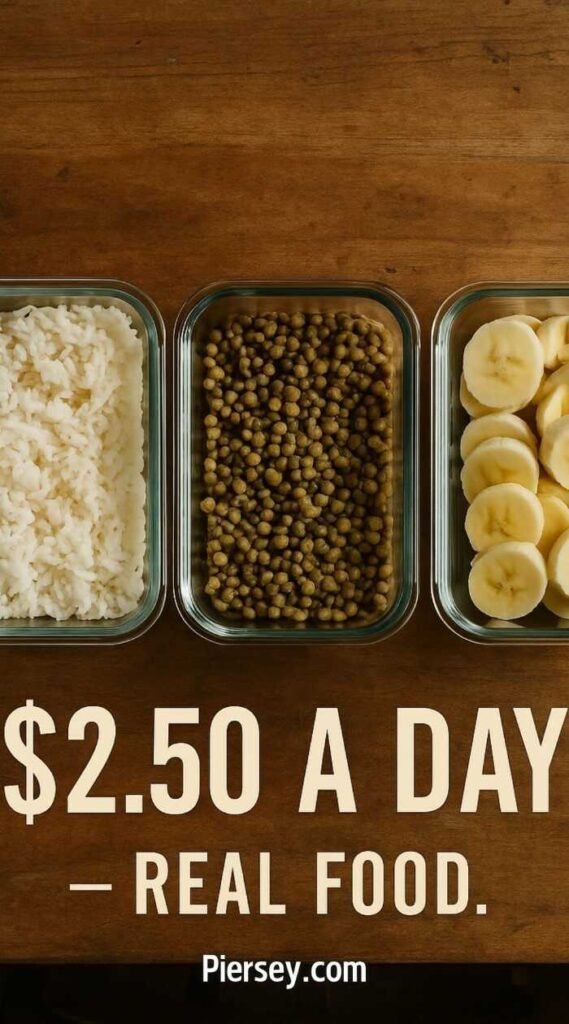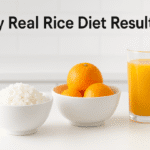Let’s be real — food prices are ridiculous right now. Every time I walk through a grocery store, I feel like I’m being personally attacked by the cost of onions. Everything costs more, but you somehow leave with less.
And then there’s the wellness industry side of it — influencers showing off “budget-friendly” meals that somehow include avocado toast, $20 protein powders, and imported supplements. Meanwhile, I’ve managed to feed myself for $2.50 a day — or just under £2 here in the UK — and I’m losing weight doing it.
No tricks, no fancy diet shakes, no secret brand sponsorships. Just rice, juice, coffee, and a few cheap add-ins. I’m eating around 2,000 calories daily, feeling full, and the scale keeps moving in the right direction.
If you’d rather see it in action, the full video version is right below 👇
The Breakdown: How $2.50 a Day Actually Works
People always ask, “There’s no way you can eat for that cheap — are you starving yourself?”
Nope. In fact, I’m eating more volume than when I was on carnivore — it just costs way less.
Here’s what my daily Rice Diet looks like, in actual numbers:
- 2 cups of white rice: about $0.60
- 1 liter of orange juice: around $1.20
- A small onion + garlic clove: roughly $0.10
- 2 tablespoons of ketchup or jam: $0.10
- 2 cups of coffee (plus sugar): $0.40
💰 Total: $2.50 — or about £1.95 a day.
That’s literally cheaper than one takeaway coffee — and instead of caffeine jitters and an empty wallet, I’m getting full, losing weight, and staying energized.
Sure, nobody’s confusing my rice-and-ketchup lunch for a Michelin meal, but that’s the beauty of it — it’s plain, simple, and efficient.
(It’s similar to what I talked about in The Lazy Way to Get Leaner (That Actually Works) — sometimes it’s the simple routines that keep you consistent.)


The Reality of Eating Cheap
Now, eating this way sounds great on paper: cheap, easy, filling. But by day three, your brain’s already screaming, “Can we PLEASE eat something with flavor?”
The key isn’t to make it exciting — it’s to make it sustainable.
Here’s what’s helped me stick to it:
- Buy in bulk.
Those 10 kg rice bags are lifesavers. You pay once, and you’re set for weeks. Plus, it’s weirdly satisfying knowing your “meal prep” is literally just… a sack of rice. - Water down your juice.
I do a 50/50 mix — half orange juice, half water. It stretches the bottle, reduces sugar, and makes it more refreshing. Honestly, it feels like a little cheat code for hydration and savings. - Add cheap flavor touches.
A squeeze of ketchup, a spoon of jam, even a dash of garlic — small things make a big difference. It’s not fancy, but it turns plain rice into something you actually look forward to.
It’s not about having exciting meals — it’s about removing decision fatigue. When your food routine is predictable, you stop obsessing over cravings. That’s been one of the biggest mental wins for me.
(I go deeper into this in Rice Diet Meal Plan: What I Eat Every Day — where I break down exactly what I eat daily and how keeping meals simple makes sticking to the plan effortless.)
Adding Protein Without Breaking the Bank
Since I recently rejoined the gym, I’ve started thinking more about recovery. Rice and jam are fine for survival, but not ideal for muscle repair.
I’m keeping it plant-based, so lentils are my new budget-friendly protein source. And here’s the best part: they’re ridiculously cheap. I picked up a 2 kg bag for £2 ($2.70), and a serving costs around $0.35 a day.
Even after adding lentils, my total cost is $2.55 — barely a nickel more. Still cheaper than a single protein bar.
- Rice: $0.60
- Orange juice: $1.20
- Lentils: $0.35
- Coffee + sugar: $0.40
Total: $2.55/day
I haven’t eaten lentils in over 15 years, so it’s been a learning curve, but so far, my digestion’s fine (thankfully). Lentils have less fiber than beans, so they’re gentler when you’re transitioning from a low-fiber diet.
What I love about this setup is how balanced it feels. It’s simple, vegan-friendly, filling, and affordable. And the more I think about it, the more I realize this isn’t just a “cheap way to eat” — it’s a way to retrain how you think about food.
Why It’s So Affordable (and Sustainable)
Let’s zoom out for a second. For the cost of one fast-food meal, I can eat for an entire week.
Rice might be humble, but it’s efficient. It stores forever, fills you up, and keeps blood sugar stable when paired with fruit or juice. It’s not fancy — it’s functional.
And that’s what most diets miss. You don’t need exotic ingredients or overpriced powders to lose weight. You just need foods that are simple, repeatable, and cheap enough that you can stick with them long-term.
(That consistency-over-perfection idea is something I explored in Rice Diet Results After 6 Weeks (Plateau + Struggles) — staying steady matters more than switching plans every week.)
Living Cheap in a World That’s Anything But
Here in the UK, the cost of living feels like it’s constantly on “hard mode.” Groceries are up, energy bills are up — even eggs are acting like luxury goods now. I swear, some days I walk past the berry section just to window shop.
That’s why this $2.50-a-day routine has been so freeing. It strips away the noise. I’m no longer stressed about my next grocery bill or wondering how to stretch meals for the week.
It’s funny — when I used to eat keto and carnivore, I’d spend £15–20 a day on meat alone. And for what? My energy was worse, my wallet was empty, and my liver was begging for a break.
Now I spend less than a bus fare on food and feel better than I have in years.
What It’s Taught Me (So Far)
There’s something strangely peaceful about eating the same few foods every day. It sounds boring, but it’s given me a sense of calm I never had before.
No meal planning, no tracking, no weighing ingredients — just food that fits my goals and my budget. I’m down 19 pounds so far, my energy’s stable, and my digestion’s the best it’s been in ages.
It’s not glamorous. It’s not Instagram-worthy. But it’s real.
What I’ve realized is that simplicity is underrated. This diet isn’t just saving me money; it’s saving me from myself — from constant cravings, from overthinking, from the endless search for the “perfect” plan.
Of course, it’s not all easy. Some days, I’d love to switch it up. There are moments where I catch myself scrolling past takeout photos like they’re art. But then I remember: this is working. It’s giving me results, structure, and peace of mind — things no trendy diet ever managed to do.


Final Thoughts
If you told me a year ago that I’d be losing weight on $2.50 a day, I would’ve laughed. But here I am — lighter, calmer, and actually saving money for once.
It’s not forever, and it’s not perfect, but it’s the most sustainable thing I’ve ever done. I don’t have to think about food constantly, I’m not breaking the bank, and I’m actually enjoying the results.
The Rice Diet might look plain, but it’s teaching me something bigger — that real health doesn’t have to come with a hefty price tag. Sometimes, all you need is a bag of rice, a plan, and a bit of patience.
So yeah, it’s basic. It’s repetitive. But it works — and in this economy, that’s all I need.



